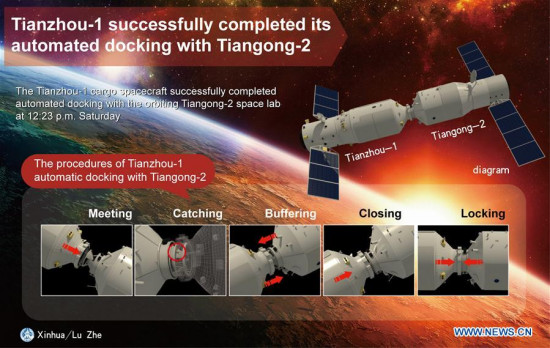
The graphics shows the procedures of Tianzhou-1 automated docking with Tiangong-2 on April 22, 2017. (Xinhua/Lu Zhe)
China has always understood that only innovation can drive the country along the trajectory to becoming a space power.
In the past year, scientists and engineers have made major breakthroughs in the technology needed for space exploration. Tianzhou-1,China's first cargo spacecraft, was launched into space and docked with the orbiting Tiangong-2 space lab last week.
A retrievable scientific research satellite, SJ-10, went into space in April 2016 and completed experiments in microgravity and space life science.
Long March-7 Y2, the medium-sized carrier rocket that was used to lift Tianzhou-1, made its maiden flight in June 2016.
Four months later, the Shenzhou-11 manned spacecraft was launched and docked with Tiangong-2 where the two astronauts lived for 33 days.
Aerospace innovation has direct benefits in people's everyday lives, with over 2,000 aerospace inventions used in various sectors to promote social and economic development. For example, turbine pump technology developed for the aerospace industry has been used in a fire pump to spray water as high as 400 meters.
China plans to launch six to eight BeiDou-3 satellites later this year, part of a plan for 35 of the country's home-grown BeiDou satellites to provide worldwide navigation services by 2020.
China's second Space Day falls on Monday. It was designated to stimulate enthusiasm for innovation and mark the anniversary of the country's first satellite launch Dongfanghong-1 in 1970.
More than four decades later, China plans to launch the Chang'e-5 lunar probe at the end of November this year. Experts predict that China could realize the dream of putting astronauts on the moon within ten years.
China's contribution to the space industry has met with widespread approval. Making peaceful use of outer space, China has signed cooperation agreements with over 30 countries and organizations including Russia, Kazakhstan, Germany, France, the European Space Agency and the United Nations Office for Outer Space Affairs.
China has helped over 20 countries and regions with 50 launches, and exported satellites to nine countries.
Furthermore, China will become the only country with a permanent space station when the International Space Station retires in 2024.
China will continue to promote innovation in space science, space technology and space applications, contributing more to both national development and the well-being of mankind.


















































